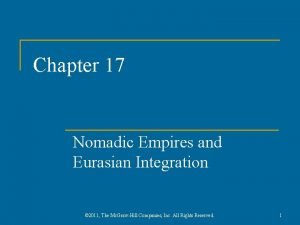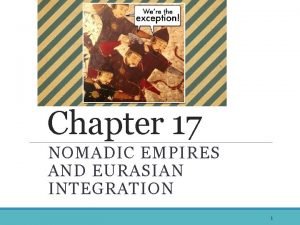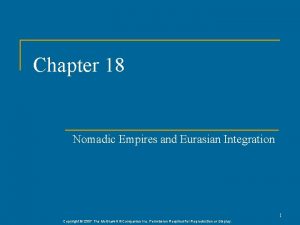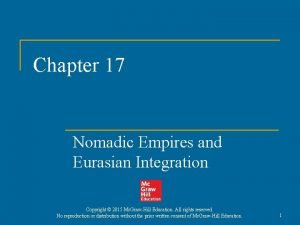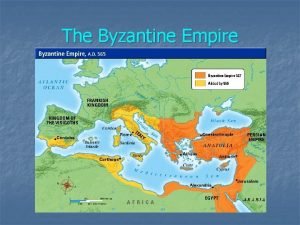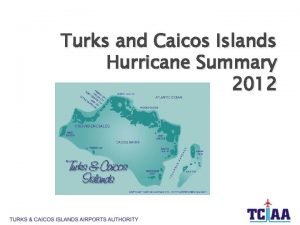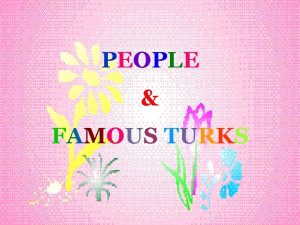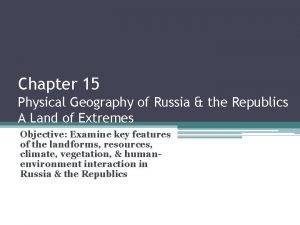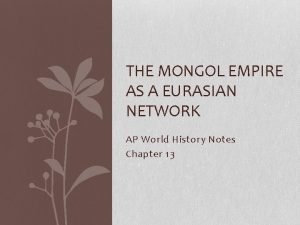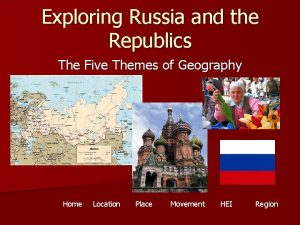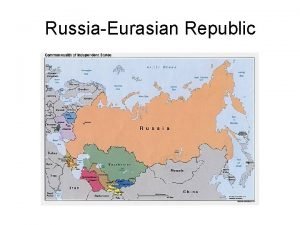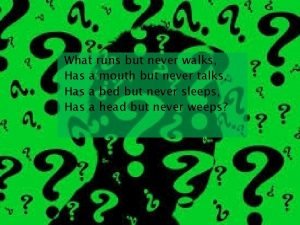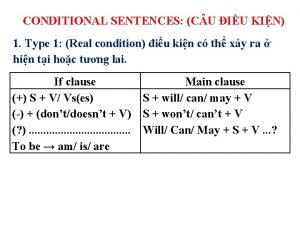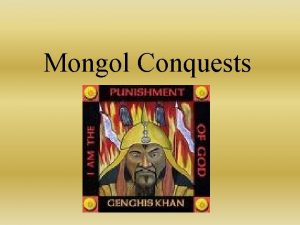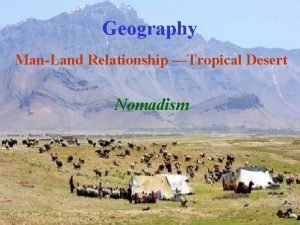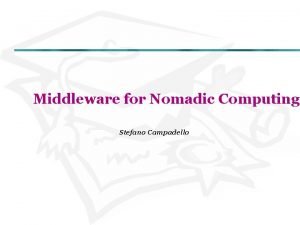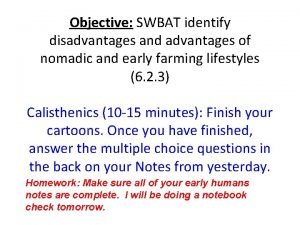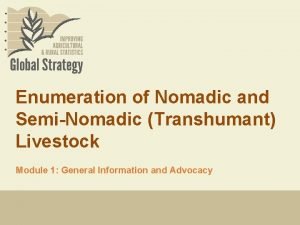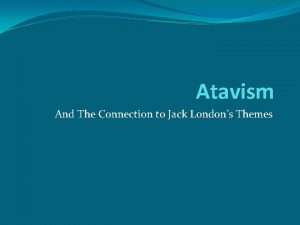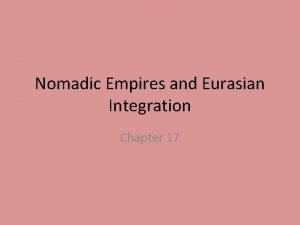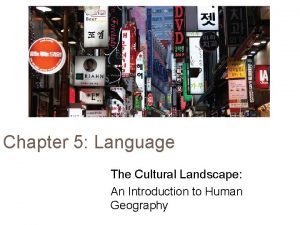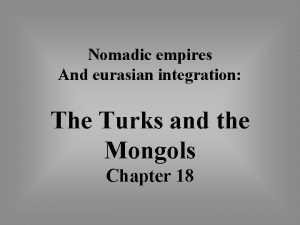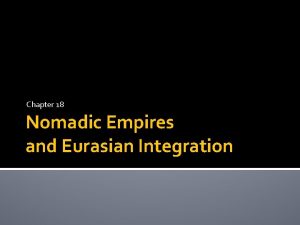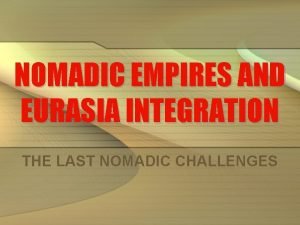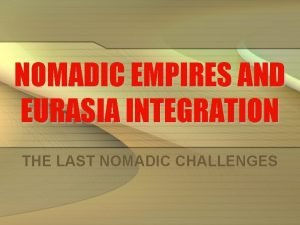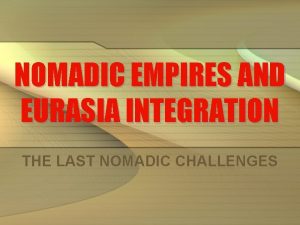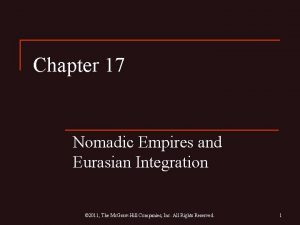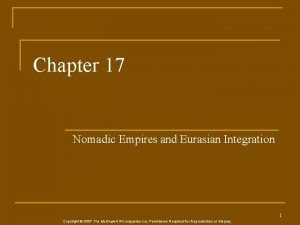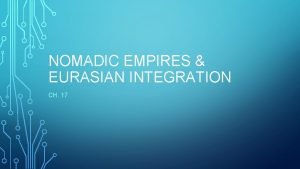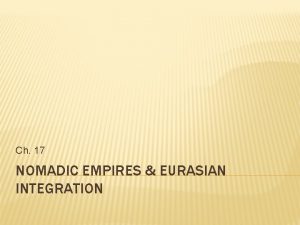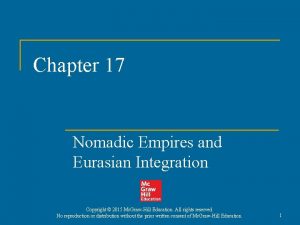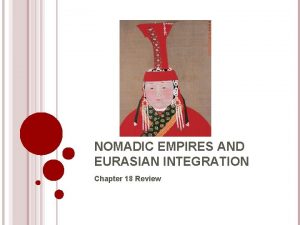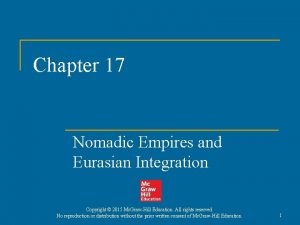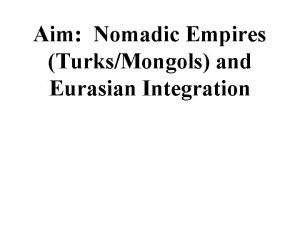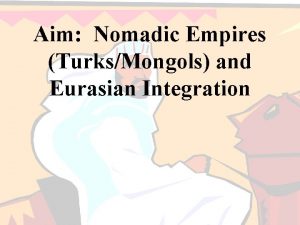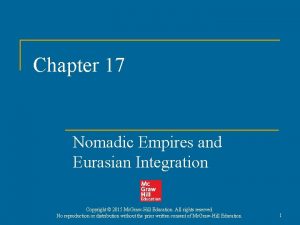Nomadic Empires Eurasian Integration The Turks Never formed






























- Slides: 30

Nomadic Empires & Eurasian Integration

The Turks • • • Never formed one large group Organized into clans All spoke related languages All were nomads or their descendants Settled societies in Persia, Anatolia and India

The Nomads • • Nomadic because of climate of steppes Not enough rain for agriculture Oases some – but mostly grasses No big rivers Good for raising cattle, horses, etc. Moved after animals thinned the grasses Followed the seasons

• Produced small amounts of leather, pottery, tools • Active traders • Were some of the ones that organized the caravans that crossed Asia

• Two classes: – Nobles – personable leaders who became the nobles – not much governing • During war – absolute authority – Commoners – could become nobles because of war conduct

• Gradually liked religions they came in contact with • By 6 th cent. many were Buddhist, or Nestorian Christians (developed writing because of this) • 10 th cent. – the Turks that lived near Abbasid converted to Islam – Carried that religion other places

• Boundaries of Islam expand with influence of Turks • Happened when leaders organized large confederations of people subject to a khan (ruler) – Had allied tribes – Lots of military power due to cavalry – Few armies could defeat them • So, several groups of Turks in 10 th cent. began to seize wealthy societies and build empires Islam & the Turks

Saljuq Turks and Abbasid Emp. • Lived on border of Abbasid for 2 cent. • Many Turks served in AB armies & lived in empire • By 1055 – the caliph of Islam recognized Saljuq leader as sultan (ruler) – name was Tughril Beg – He and successors extended his power • Caliph became a figurehead

Turks and Anatolia • Anatolia was breadbasket of Byz. Emp. • Turks migrated in during early 11 th cent. • 1071 – Saljuq forces defeated Byz. army at Battle of Manzikert • Peasants mostly happy – saw them as saviors • Turks set up own political institutions • Levied taxes on Orthodox Church

• Welcomed converts to Islam • 1453 – Ottoman Turks captured Constantinople • Anatolia (Turkey) became a Turkish, Islamic land

Turks & India • Mahmud of Ghazni led raids into rich areas of India to plunder – Gradually became interested in staying • 13 th cent. , Turks became the Sultanate of Delhi • Conquered all of N. India • Could not conquer S. India

• Constant challenges from Hindu princes • Sometimes had to defend borders from other Turks or Mongols • Mahmud raided Buddhist & Hindu temples, etc. – Took their wealth, destroyed, killed them – Wanted them to convert to Islam

The Mongol Empires • Nomadic Mongols lived on steppe lands of east central Asia • Organized into clans or tribes • Allied with Turks sometimes • Didn’t organize states before the 13 th cent. • Chinggis Khan would make largest empire to this point – Would dissolve in 100 yrs.

Chinggis Khan & the Mongols • • • Name was Temujin – born 1167 Father was warrior - had alliances w/several clans He was poisoned and alliances ended Temujin lived in poverty – several murder attempts. Later made alliance with clan leader

• Was master of steppe diplomacy – display of courage in battle with loyalty to allies, but willingness to betray them to improve position • Brought all Mongols into confederation in 1206 • Assembly of leaders proclaimed him Chinggis Khan (universal ruler)

• Forced men to join military – Chose leaders based on talent or loyalty • Capital at Karakorum • Created strong political state less troubled by conflict between tribes • Most important institution was army – Had great horsemanship – Very mobile – travel 100 miles a day

• If enemies didn’t resist, usually spared their lives • Gave generous treatment to artisans, craftsmen and those with military skills • If enemies resisted – sometimes slaughtered entire population

• 1211 – raids in N. China gradually moved more towards conquest • 1215 captured capital near Beijing – Khanbaliq was Mongol capital • Led another force to Persia – Was ruled by successor to Saljuqs known as Khwarazm shah

– – – CK tried to open trade and diplomacy But Shah despised Mongols Had Mongol envoys murdered Next year, CK took revenge Destroyed cities – killed 100’s of 1000’s Destroyed qanat systems – reduced agr. production

The Mongol Empire • Chinggis Khan died – power struggle b/w sons and grandsons • Eventually divided empire into 4 regional kingdoms • Most talented of his descendants was Khubilai Khan – a grandson – would rule China

Khubilai Khan & China • • • Ruthless against enemies Interested in culture Worked to improve welfare of all subjects Promoted Buddhism, but was religiously tolerant Marco Polo lived in his court for 2 yrs. – Praised him for his generosity • Presided over empire at its height

• • Named Great Khan in 1260 Conquered Song dynasty and ruled all of China 1279 – proclaimed himself emperor Called his dynasty the Yuan – It ruled until 1368 • Tried to invade Vietnam, Cambodia and Burma but failed – Not used to humid jungles or guerrilla tactices • Also tried to invade Japan, but two typhoons stopped him.

• Mongols did not mingle with subjects • Chinese couldn’t learn Mongol language • Outlawed marriage between Chinese and Mongols • Ended privileges enjoyed by Confucian scholars

• Ended Confucian education system and exam • Tolerated all cultural and religious traditions • Most Mongols continued to follow native shamanist cults (animism)

Golden Horde • Mongol group that overran Russia (didn’t occupy it – made them pay tribute) • Mid 15 th century – Princes of Moscow rejected Mongol authority • Mid 16 th century – Russia controlled the steppes.

Persian Ilkhanate • Hulegu (Khubilai’s brother) brought down Abbasid Empire • Established Mongol Ikhanate in Persia • 1258 – captured Baghdad, executed caliph, massacred over 200, 000

• Local Persians allowed to serve in low level gov’t positions • Sometimes could administer the Ilkanate as long as they brought in taxes • Assimilated into Persian culture • Tolerated all faiths • Mongols eventually turned to Islam in Persia

Mongols and Eurasian Integration • Mongols brought much destruction • However, they also brought integration of different societies • Also, linked Eurasian lands • Encouraged travel and communications networks – This promoted: • • trade diplomacy missionaries and migration

• Kept trade routes safe and secure • Set out diplomats and had embassies in other places • Kept ties with Korea, Vietnam, India and part of W. Europe • Buddhists and Christians began to spread through Mongol lands

• Mongols also sponsored resettlement – Didn’t have many craftsmen or specialists – Recruited them from their allies and conquered people – Moved them to where they could be useful • All this promoted Eurasian integration by increasing communications and exchange
 Chapter 17 nomadic empires and eurasian integration
Chapter 17 nomadic empires and eurasian integration Chapter 17 nomadic empires and eurasian integration
Chapter 17 nomadic empires and eurasian integration Chapter 18 nomadic empires and eurasian integration
Chapter 18 nomadic empires and eurasian integration Chapter 17 nomadic empires and eurasian integration
Chapter 17 nomadic empires and eurasian integration Maritime and land based empires
Maritime and land based empires Seljurk turks
Seljurk turks Turks and caicos hurricane season
Turks and caicos hurricane season Famous turks
Famous turks Turks and caicos colors
Turks and caicos colors Vikings vs mongols
Vikings vs mongols Chapter 15 physical geography of russia and the republics
Chapter 15 physical geography of russia and the republics The mongol empire as a eurasian network
The mongol empire as a eurasian network 5 themes of geography russia
5 themes of geography russia What country made up the soviet union
What country made up the soviet union What can run but never walks has a mouth
What can run but never walks has a mouth He never polishes his shoes so he never looks smart
He never polishes his shoes so he never looks smart He never polishes his shoes so he never looks smart
He never polishes his shoes so he never looks smart Our god never fails
Our god never fails We are never weary of the grand old song
We are never weary of the grand old song Your love never fails, it never gives up
Your love never fails, it never gives up Asian massage mongol
Asian massage mongol Nomadic herding definition ap human geography
Nomadic herding definition ap human geography Nomadic user disebut juga
Nomadic user disebut juga Nomadic computing examples
Nomadic computing examples Advantages and disadvantages of nomadic herding
Advantages and disadvantages of nomadic herding Semi nomadic definition
Semi nomadic definition Old longings nomadic leap
Old longings nomadic leap This is a nomadic desert tribesmen
This is a nomadic desert tribesmen Language youtube
Language youtube Nomadic religion
Nomadic religion Language
Language
